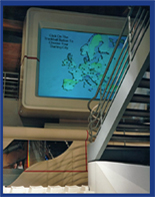 |
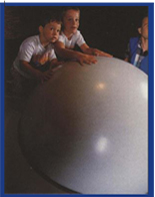 |
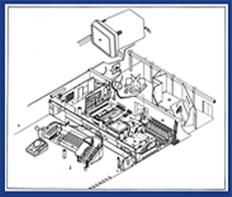 |
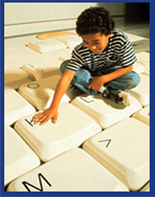 |
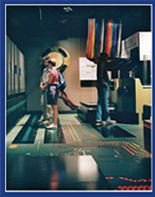 |
The giant exhibit featured an authentic-looking, two-story working model of a desktop computer enlarged to 50 times its normal size. The purpose of the exhibit was to show the anatomy of a computer and to explain how the various parts worked and communicated with each other. The Walk-Through Computer ran a program called "World Traveler" Ė a route-finding application. Using a giant (9'x6'6"x5') trackball to point, they could choose starting and destination points from among more than 300 major world cities. The computer found the shortest land route between them, and offered a slide show on the giant monitor of sights they would see along the way. Walking inside the computer, visitors saw how the computer performed its route-finding task. Pulsing lights simulated the flow of data between the internal components and peripherals. Visitors walked past a ceiling-high video-processing printed circuit board to view the microprocessor. Looking down through one of the many viewports, they inspected the chipís circuits magnified 500 times. They also saw microelectronic circuits in action on banks of random access memory chips, and peered into a giant spinning disk drive retrieving data. An entertaining video in the Software Theater introduced software concepts, supplemented by interactive "learning stations," on computer architecture and programming. The Walk-Through Computer captured the imagination of media around the world from the TODAY show, ABC Evening News, CNN, TV networks in Germany, Japan, and Australia, as well as the AP, UPI, The London Times, Der Spiegel, The New York Times, and Newsweek. It also led to a major surge in Museum attendance. |
Opening: June 23, 1990 Square Footage: 5,300 sq.ft. Cost: $1.2 million Sponsors: The Kapor Family Foundation, The Alfred P. Sloan Foundation, Digital Equipment Corporation, Apple Computer, AT&T, Intel Corporation Donors: Kensington Microwave, Ltd., Maxell Corporation of America, Lotus Development Corporation Contributors: Cirrus Logic, Inc., Institutions and individuals who contributed to the exhibit Funding: Grants: Development: Oliver Strimpel, David Macaulay, Donald Morrison, John Palfreman, Dean Winkler Design: Richard Fowler, The Science Museum, London/Bradford Construction: F. W. Dixon Company, Mystic Scenic Studio (1995 enhanced version) Exhibit Advisors: Art Bardige, Gordon Bell, Daniel Dennett, Allison Druin, Signe Hanson, Gardner Henrie, Danny Hillis, David Macaulay, Philip Morrison, Phylis Morrison, David Patterson, Jonathan Rotenberg, Richard Rubinstein Sponsers for Walk-Through Computer 2000: Cirrus Logic, Inc., Intel Corporation, 3Com Corporation, Adaptec, Inc. American Power Conversion (APC), Hayes Microcomputer Products, Inc., Kensington Microwave Ltd., NEC Technologies, Inc., Philips Electronics, Phoenix Technologies Ltd.; Quantum Corporation, Texas Instruments Building the Walk-Through Computer, TCM Annual Report 1990 Walk-Through Computer, TCM News May-June 1990
Walk-Through Computer, Insider's Reports Walk-Through Computer Pamphlet Walk-Through Computer, Press Kit 1990 Walk-Through Computer 2000, TCM News Summer 1995
Walk-Through Computer 2000, TCM Annual Report 1996 Walk-Through Computer 2000 Layout Video film "How Computers Work: A Journey into the Walk-Through Computer" World Traveler program and slideshow Face Matcher program Dean Winkler's video "Explaining Software: The Software Theater" Six Interactive Learning Stations (computer archiecture, how a computer program is created) |
Updated: February 2015